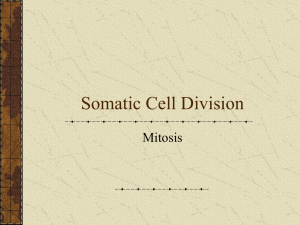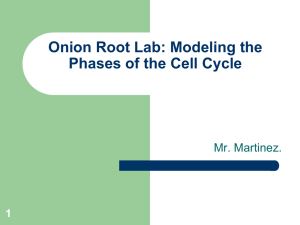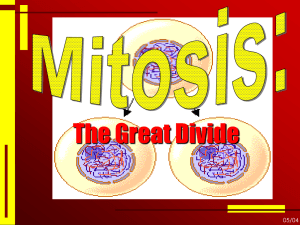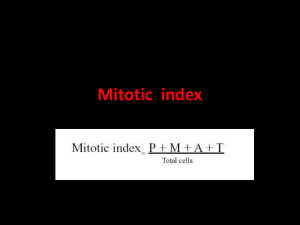Mitosis in Onion Root Tip Cells Lab Exercise
advertisement
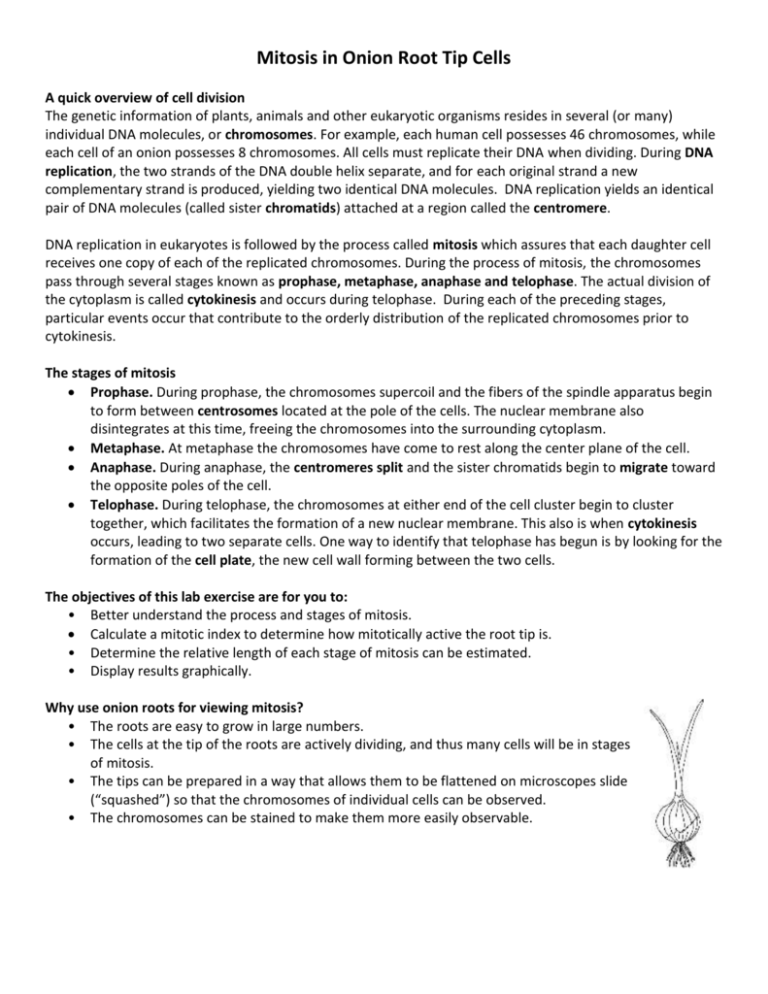
Mitosis in Onion Root Tip Cells A quick overview of cell division The genetic information of plants, animals and other eukaryotic organisms resides in several (or many) individual DNA molecules, or chromosomes. For example, each human cell possesses 46 chromosomes, while each cell of an onion possesses 8 chromosomes. All cells must replicate their DNA when dividing. During DNA replication, the two strands of the DNA double helix separate, and for each original strand a new complementary strand is produced, yielding two identical DNA molecules. DNA replication yields an identical pair of DNA molecules (called sister chromatids) attached at a region called the centromere. DNA replication in eukaryotes is followed by the process called mitosis which assures that each daughter cell receives one copy of each of the replicated chromosomes. During the process of mitosis, the chromosomes pass through several stages known as prophase, metaphase, anaphase and telophase. The actual division of the cytoplasm is called cytokinesis and occurs during telophase. During each of the preceding stages, particular events occur that contribute to the orderly distribution of the replicated chromosomes prior to cytokinesis. The stages of mitosis Prophase. During prophase, the chromosomes supercoil and the fibers of the spindle apparatus begin to form between centrosomes located at the pole of the cells. The nuclear membrane also disintegrates at this time, freeing the chromosomes into the surrounding cytoplasm. Metaphase. At metaphase the chromosomes have come to rest along the center plane of the cell. Anaphase. During anaphase, the centromeres split and the sister chromatids begin to migrate toward the opposite poles of the cell. Telophase. During telophase, the chromosomes at either end of the cell cluster begin to cluster together, which facilitates the formation of a new nuclear membrane. This also is when cytokinesis occurs, leading to two separate cells. One way to identify that telophase has begun is by looking for the formation of the cell plate, the new cell wall forming between the two cells. The objectives of this lab exercise are for you to: • Better understand the process and stages of mitosis. Calculate a mitotic index to determine how mitotically active the root tip is. • Determine the relative length of each stage of mitosis can be estimated. • Display results graphically. Why use onion roots for viewing mitosis? • The roots are easy to grow in large numbers. • The cells at the tip of the roots are actively dividing, and thus many cells will be in stages of mitosis. • The tips can be prepared in a way that allows them to be flattened on microscopes slide (“squashed”) so that the chromosomes of individual cells can be observed. • The chromosomes can be stained to make them more easily observable. Part A: Data Collection The photographs below illustrate the stages of the cell cycle in the onion cell. IMAGE 12 35 67 89 10 PHASE Interphase Prophase Metaphase Anaphase Telophase Observe every cell in the two images and determine which phase of the cell cycle it is in. This is best done in pairs. One partner observes the images and calls out the phase of each cell while the other partner tallies the results. Students should take turns as observer and recorder. Roles should be switched for the second paper of view. Part B: Estimating Timing of Cell Cycle Phases The relative length of time required for the completion of the cell cycle is directly correlated with the number of cells observed in the various stages. From this information and how long the cycle takes, the time sequence of each of these stages can be worked out. Create a table to summarize the number of cells in each phase of the cell cycle. Then, convert the number of cells in each stage of the cell cycle to a percentage, using the total number of cells counted as 100%. In an onion root tip, the mitotic cycle generally takes about 24 hours. This is an approximation; the actual time may vary depending on the condition of the roots during growth. On the basis of a 24-hr cycle, work out the approximate time in hours that is spent in each stage. Include this information in your data table. Show a worked example calculation for 1) the percentage of cells and 2) the time per each stage. Create an appropriately titled and labeled graph that displays the time of a 24 hour cycle for each stage of the cell cycle. Need help selecting which type of graph to use? Check your student guide pg. 40. Answer these questions in complete sentences: 1. Which of the stages is the shortest? Does this comply with what you know to be the chromosomal events during the stage? Why? 2. Which of the stages seems to be the longest in duration? Does this comply with the information you have received about the events during this stage? Why? 3. If your observations had not been restricted to the area of the root tip that is actively dividing, how would your results have been different? Part C: Calculating the Mitotic Index In any population of mitotically active cells, only some of the cells are in mitosis at any one time. The proportion of dividing cells is defined as the mitotic index. Mitotic Index = Number of Cell in Mitosis / Total Number of Cells Calculate the mitotic index for the onion root tip. Show a worked example calculation for the mitotic index. 4. Read this abstract. How can calculations of the mitotic index be used in the prediction and/or diagnosis of cancer? Knowing that cancer is a result of uncontrolled cell division, would a cancerous-tumor have a larger or smaller mitotic index than a non-cancerous tissue?


